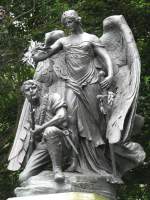
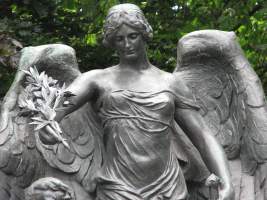 Colton's Boer War memorial.
Colton's Boer War memorial.
The Boer War Memorial, above, is the statue in Worcester of most artistic significance. A kneeling infantryman with a bayonet and his bullets round his neck is sheltered by a particularly graceful angel, her wing protectively around him, and holding an olive branch above his head. Her other hand holds a sword, point downwards, with a wreath around the guard. Note especially the treatment of the gauzy drapery across her torso, the poise of the hands, and the feathers of the wings. This exquisite art nouveau group is the work of W. R. Colton, and is comparable to his other Boer War memorial, in London by the Mall on the north side of St James s Park. There are few war memorials as good as this one.
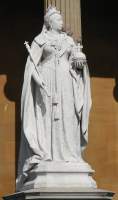 Brock's Queen Victoria for Worcester, his home town.
Brock's Queen Victoria for Worcester, his home town.
Our second statue is the Queen Victoria by Thomas Brock, on Foregate Street, in front of a fine Classical building which is Shire Hall, a building used by Worcester s Crown Court. When we think of Brock, we think of course of his defining work, the Queen Victoria Memorial in front of Buckingham Palace, with its vast statue of the Queen and many accompanying statues. But Brock has many Queen Victoria statues to his name. The one in Birmingham is the same as the one in Worcester (but the former is in fact a 1951 replica of the original). The one in Hove is very similar, but carries a globe with a winged Victory rather than the globe with a cross as at Worcester, alongside her sceptre; a somewhat different but clearly related version is in London on Carlton House Terrace (near to Colton s Boer War Memorial noted above), where it is hardly ever noticed. These are shown below. We may also mention another version of the Worcester piece in Carlisle, and another in Belfast. The significance of the Worcester statue is that Worcester was Brock s birthplace, and he studied there at the Government School of Design, before leaving for London in 1866/7 to continue his artistic training at the Royal Academy Schools.
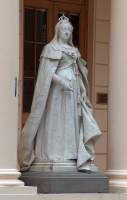
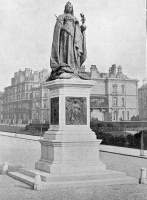
 Queen Victoria statues in Carlton House Terrace, Hove, Birmingham.
Queen Victoria statues in Carlton House Terrace, Hove, Birmingham.
The statue shows the Queen as fairly youthful, but still instantly recognizable, wearing a richly decorated robe and an enveloping mantle characteristic of many portraits of her. The statue was cleaned in 2008, and our picture was taken soon after this a bit too soon perhaps, because it has not yet reacquired the layer of grime so necessary to give marble statues their proper three-dimensionality of aspect.
The Worcester City Art Gallery and Museum contains a bust by Brock of Charles Hastings, a founder of the British Medical Association, and after whom the museum was previously named. A strong, unsentimental portrait in marble, very alive.
Two other statues in the museum must be mentioned. Firstly William Calder Marshall s lively Sabrina thrown into the Severn, dating from 1880, showing some Cornish or German tribesman throwing the unlucky princess into the river which took her name. The tribesman is heroic and muscular and has caught up his captive, grabbing her by chest and thigh, preparatory to releasing her into the water; the semi-naked girl strains unavailingly against him in a moment of high drama. Secondly, a small maquette by C. Sergeant Jagger for his statue called The Sentry or The Sentinel which is walked past by many thousands of commuters each day in Paddington Station (see this page).
The current museum building, opened 1896, is a handsome terra-cotta building with some sculpted decoration, including on the top a fine free-standing terra cotta figure of a girl with sword and long frond which is probably a quill pen. In the rather sketchy but bold and successful manner so often found with terra cotta works, as typically the case, there is no sign of who the sculptor was. Other decoration on the building includes two pairs of angels with the sigil Victoria Regina, wild cherubs of a Bacchanalian character gathering a harvest from some vine, and a splendidly ornate Royal coat of arms.
A local sculptor, who unlike Brock remained purely of local repute, was Thomas White of Worcester, and his sculpture for the Guildhall awaits a separate page on this site.
Finally, we should mention in passing, though it falls well outside the period of interest to these pages, the 1979 bronze statue of Elgar, by the sculptor Kenneth Potts. The contemporary clothing is sketchy, and of little interest, but the head is good and the whole a worthy addition to the statues in Worcester.
Sculpture in England // Sculpture pages
Visits to this page from 8 June 2012: 10,060